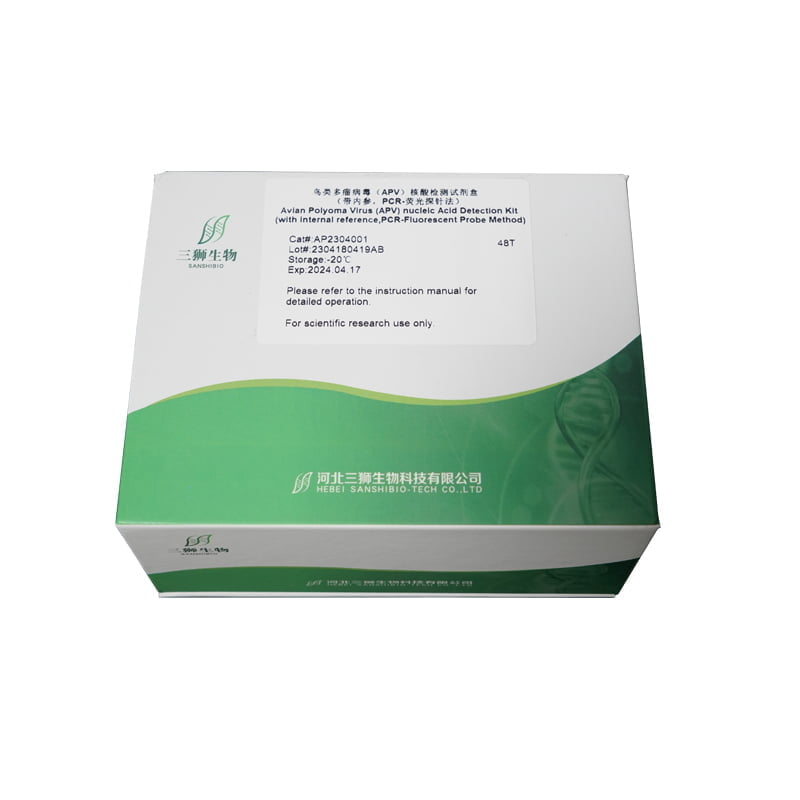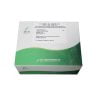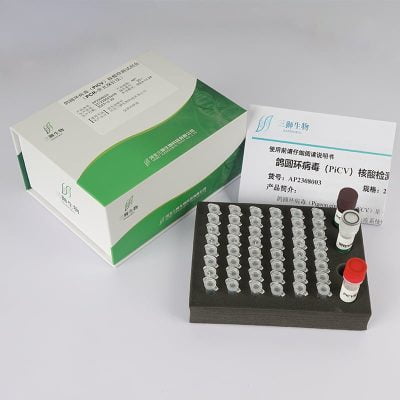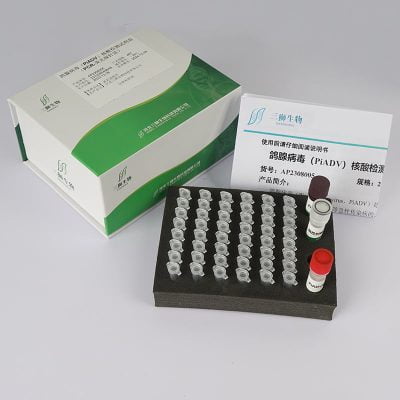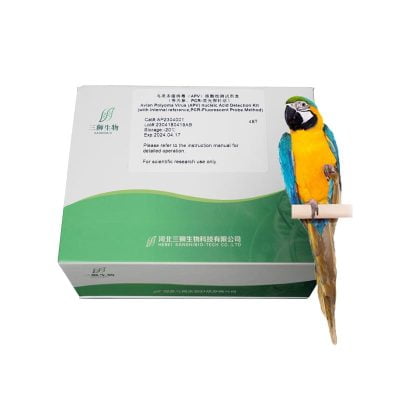This product needs to be packed with ice bags and shipped through FedEx or UPS.
Predstavljanje proizvoda:
This reagent kit can perform amplification detection of the conserved genes of Avian Polyoma Virus (APV) in samples such as bird feathers, krv, tissues, oral/genital swabs, itd. By introducing an endogenous internal reference, the nucleic acid extraction and amplification process can be monitored to ensure the accuracy of the test results.
Sadržaj proizvoda:
| Komponente reagensa | AP2304001-01(24T) | AP2304001-02(48T) |
| APV reaction solution | 23µL/well×8wells/strip×3strips | 23µL/well×8wells/strip×6stips |
| APV Positive control | 100μL | 100μL |
| Negativna kontrola | 100μL | 100μL |
Uvjeti skladištenja:
Čuvati na -20℃, rok trajanja je najmanje 12 mjeseca
Eksperimentalni rad:
1. Sample preparation (Sample preparation area)
1.1 Sample requirements:
- Feathers: Collect a minimum of 5 feathers from the chest, abdomen, or legs (including the feather shaft portion), and do not use naturally shed feathers.
- Blood: Koristite EDTA kao antikoagulans, do not use heparin as an anticoagulant. Fresh whole blood should be used, or it can be stored at 2~8℃ for up to 7 dana, or stored at -20℃ for up to 3 mjeseca. Avoid repeated freezing and thawing as much as possible.
- Tkivo: Take fresh muscle or organ tissue (avoid using samples with skin, tendons, or fascia that are difficult to process) of no more than 100mg. Prepare tissue homogenate using 200-500μL of sterile water, and then proceed with subsequent sample preparation.
1.2 Sample preparation:
- Refer to the manual of the Three Lions Biotech “Komplet za brzu ekstrakciju životinjske genomske DNK (za PCR analysis)” (Part Number: DP202), or other nucleic acid extraction kits/methods that meet the relevant requirements, for the extraction of processed samples.
- Place the extracted sample nucleic acid in an icebox and try to proceed with the testing promptly.
- It can be stored at 4°C for up to 7 days or at -20°C for up to 6 mjeseca.
2 . Preparation of reaction system (Reaction area for adding samples).
2.1 Take out n+2 reaction tubes containing APV positive control, APV negative control, and the reaction solution needed for the experiment (n represents the number of samples to be tested, plus 1 positive control, i 1 negative control). Thaw the reagents completely at room temperature, centrifuga za 10 sekundi, and spin the liquid inside the tube walls and caps to the bottom of the tube. Place them in an icebox for later use.
2.2 Zatim, add 2μL of negative control, ekstrahirani uzorak nukleinske kiseline, and APV positive control to the reaction solution in sequence. Close the tube caps, make proper records, and ensure that the total volume of each reaction is 25μL. Thoroughly mix the contents, centrifuga za 10 sekundi, and then proceed with the amplification experiment on the PCR instrument.
3. PCR amplification (Amplification and product analysis area).
- The PCR amplification process is as follows:
- Pre-denaturation at 95℃ for 3 minuta.
- Denaturation at 95℃ for 10 sekundi.
- Annealing and extension at 60℃ for 40 sekundi, for a total of 35 ciklusi.
- Collect fluorescence signals at 60℃.
- In the fluorescence detection, select FAM for the first channel (for APV specific gene), and select VIC/HEX for the second channel (for endogenous reference gene).
- If using an ABI series real-time fluorescence quantitative PCR instrument, you may contact the manufacturer in advance or add ROX calibration dye by yourself if needed; inače, follow the normal procedure.
4. Result determination
4.1
- If the Ct values of the positive control in both the FAM channel and the VIC/HEX channel are <30 and show an “S”-oblikovana krivulja pojačanja, and the negative control has no Ct value or a Ct value ≥35 and no “S”-oblikovana krivulja pojačanja, the experimental result is valid.
- Inače, the experiment should be repeated, and if the repeat experiment is still invalid, please contact the technical personnel.
4.2
- The Ct value of the sample in the VIC/HEX channel should be ≤32 and show an “S”-oblikovana krivulja pojačanja, indicating that the sample extraction and amplification are effective.
- If there is no Ct value or the Ct value is 32 < Ct ≤ 35 in the VIC/HEX channel, it indicates that the sample nucleic acid extraction is not up to standard or there is strong inhibition interference (such as residues of alcohol or disinfectants, antikoagulansi, itd.) that inhibits amplification.
- It is recommended to reprocess the sample for nucleic acid extraction and amplification.
4.3 After the detection in the VIC/HEX channel is valid, the determination in the FAM channel is performed as follows:
- Ct vrijednost ≤ 32 i an “S”-promatra se oblikovana krivulja pojačanja, it is determined as positive for APV, indicating the presence of APV virus in the sample.
- Ct value is 32 < Ct < 35, it is considered as suspicious, and the sample should be retested (by re-extracting and testing the nucleic acid, it is suggested to first exclude “false-positive” results caused by environmental aerosol contamination). If the retest in the FAM channel after excluding aerosol contamination shows a Ct value < 35 and a clear amplification curve, it is determined as positive for APV; inače, it is determined as negative.
- Nema Ct vrijednosti ili Ct vrijednost ≥ 35 i br “S”-oblikovana krivulja pojačanja, it is determined as negative for APV, indicating that the APV virus was not detected in the sample.
Mjere predostrožnosti:
- Za sprječavanje kontaminacije, the experiment should be conducted strictly with partitioned operations. It is preferable to have physical isolation between partitions to avoid cross-contamination caused by human factors. Tijekom eksperimenta nosite laboratorijske kute i rukavice od lateksa, and use separate tools in different areas. Change gloves and lab coats as needed. After the PCR, do not open the lids immediately. Wait for sufficient cooling before opening for sampling to minimize aerosol contamination.
- Prije upotrebe potpuno otopite reagense, but avoid repeated freezing and thawing. Follow the instructions strictly for reagent preparation, sample addition, and other steps. The workbench, centrifuge, pipete, and other instruments should be regularly disinfected using chlorine-containing disinfectants, ethanol, nucleic acid contamination removal agents, or ultraviolet lamps.
- A negative result does not necessarily mean a male. Unknown mutations, poor sample quality, low concentration, or the presence of strong inhibitory substances in the nucleic acid extraction (testing) can also lead to “negativan” results. This kit is only used for the specific amplification of the CHD-W gene in parrots. For other products, please consult the manufacturer.
- This product is for single use only. Do not repeatedly freeze and thaw. It is for scientific research purposes only and should not be used for clinical diagnosis or other purposes.
